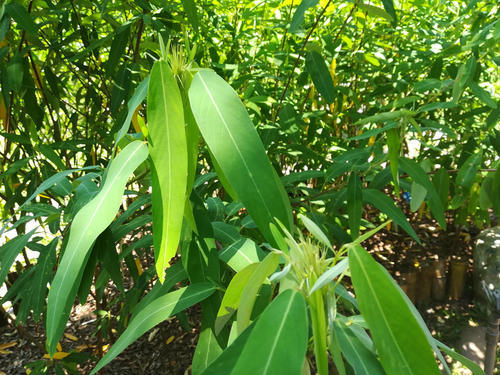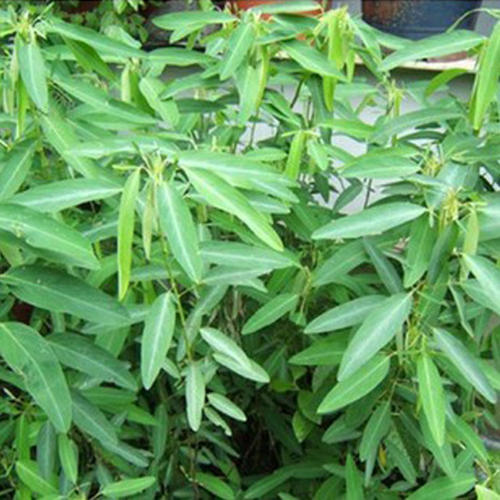Desmodium Gyrans Profile
Written by Lisa
Nov 09 2020

When Desmodium gyrans "dancing", its pair of side leaflets can rotate obviously: either making a 360-degree loop, or swinging up and down, sometimes the two leaflets close together upwards at the same time, and then slowly separate and flatten, like a butterfly Dancing wings lightly; sometimes one upward and the other downward, like a graceful dance in rhythmic gymnastics; sometimes many lobules dance at the same time, one after another. Although the lobules on the same plant move faster and slower, they Quite a rhythm, a spectacle.
When night falls, desmodium gyrans enters a "sleep" state, with its petioles sticking up to the branches, and the top leaflets drooping, like a folded knife. With the dawn, the angle of its leaf axils increases, and the parietal lobules are gradually stretched out, and it will be ready to start a new day.
Desmodium Gyrans Pictures

Morphological characteristics of Desmodium gyrans
1. Branches and leaves of Desmodium gyrans
Desmodium gyrans is an erect small shrub plant that can reach 1.5 meters in height. The stem is single or branched, cylindrical, slightly striated, without hairs. The leaves of Desmodium gyrans have three compound leaves, with small or no lateral leaflets, but only single leaflets. The stipules are narrow triangular, 10-14 mm long, 1.7-2.3 mm wide at the base, usually oblique, glabrous, with sparsely pubescent edges; petioles 1.1-2 cm long, with grooves on the upper face, sparsely sparse Unfolded pubescent; terminal leaflets oblong or lanceolate, 5.5-10 cm long, 1-2.5 cm wide, apex rounded or sharply pointed, slender, blunt or round at base, glabrous on top, and pasted below Vulgaris pubescent, 8-14 lateral veins on each side, not reaching the edge of the leaf, small lateral leaflets, oblong or linear or sometimes absent; small stipules subulate, 3-5 mm long, glabrous on both sides; The petiole is about 2 mm long.
2. Flowers of Desmodium gyrans
The flower flocs of Desmodium gyrans are in the form of panicles or racemes terminal or axillary, and the inflorescence shaft has curved hook-like hairs. Densely formed broad ovate bracts that fall off during flowering. The pedicel is 1-4 mm in length at anthesis, extended to 3-7 mm after anthesis, with spreading hairs; the calyx is membranous, 2-2.5 mm long, with hairs on the outside, the calyx tube is 1-1.5 mm long, and the upper lobes are 2-lobed, long About 1 mm, the lower lobes are about 1 mm long; the corolla is purple-red, the flag petals are 7.5-10 mm long and wide, the wing petals are 6.5-9.5 mm long, 4-5 mm wide, and the keel petals are about 10 mm long and 3 mm wide. , With long petiole, stamens 8-11 mm long; pistils 10-12 mm long, ovary puberulent. Flowering period is from July to September.

3. Fruit of Desmodium gyrans
The fruit of Desmodium gyrans is sickle-shaped or straight, between 2.5-4 cm long and 5 mm wide, with straight abdominal sutures and slightly constricted dorsal sutures. When mature, it cracks along the dorsal sutures and is sparsely hooked. Short hairs, 5-9 pod nodes; seeds 4-4.5 mm long and 2.5-3 mm wide. The fruit period is between October and November.
Desmodium gyrans growth habit
Desmodium gyrans like sunshine and warm and humid environment with good drought-tolerant and barren tolerance. Desmodium gyrans is a plant that is very sensitive to sound waves of a certain frequency and intensity, and is also related to temperature and sunlight. When the temperature is above 24°C and the weather is sunny and sunny, the leaflets will cross-turn, kiss and bounce on their own. The two leaves can rotate up to 180 degrees and then bounce back. When the temperature is 28-34℃, or on a sultry sunny day or a sunny day after rain, the whole plant will have dozens of pairs of leaves that sometimes embrace and dance lightly, making people dazzling and giving people a fresh, wonderful and mysterious feeling. When night falls, it sticks the leaves to the branches and snuggles tightly. It is a rare flower.

Desmodium gyrans distribution
Desmodium gyrans is mainly distributed in Fujian, Jiangxi, Guangdong, Guangxi, Sichuan, Guizhou, Yunnan and Taiwan provinces in China and some countries such as India, Nepal, Bhutan, Sri Lanka, Thailand, Myanmar, Laos, Indonesia, Malaysia, etc. It is often born in hilly slopes or ravine shrubs.
The reason for Desmodium gyrans dance
Botanists generally believe that the reason for Desmodium gyrans and dancing is related to sunlight. When there is light, it dances, and when there is no light, it breathes, just like a sunflower turning its head and stem toward the sun. Specific in-depth research, there are various differences. Some believe that it is caused by the change in the intensity and direction of the weak current in the plant; some believe that it is caused by the change in the growth rate of plant cells; others believe that it is an adaptability of organisms, which can avoid some stupidity when dancing. The damage of insects, and then grows in the tropics, the two leaflets turn once, can avoid the intense heat, to cherish the water in the body. However, there are still many questions about why the Desmodium gyrans stop day and night. To solve this mystery, botanists need to continue to explore.

The legend of Desmodium gyrans
In ancient times, in Xishuangbanna, there was a beautiful and kind-hearted Dai farm girl named Duoyi. She loved dancing by nature and had outstanding dancing skills. She often toured the villages of all ethnic groups during the slack time in the farming period, performing dances for the poor people. She is graceful and dancing like a golden peacock drinking and frolicking in a spring in the forest, and like a crane flying freely over the field. People watching her dance can’t help being intoxicated, forgetting their sorrow, their pain, and even themselves. . As time goes by, Duoyi's reputation gradually rises and his reputation is far-reaching. Later, a hateful big chieftain led many family members to snatch Duoyiqiang to his home and asked Duoyi to dance for him every day. Duoyi swore to the death, resisted with death, escaped when the guards were not paying attention, jumped into the Lancang River, and drowned. Many poor people organized spontaneously to salvage Duoyi's body and held a grand funeral for her. Later, a beautiful grass grew on Duoyi's grave. Whenever the music played, it danced with the festival.
Latest Updated
- Benefits of Bugleweed - 7 Science-backed Health Benefits
- Bugleweed Dangers & Side Effects - Is It Poisonous?
- How to Plant Evergreen Trees - What You Should Know
- When to Plant Evergreens - Grow Guide for Evergreen Trees
- 12 Wonderful Evergreen Shrubs for Your Garden
- 12 Popular Evergreen Plants with Pictures for Beginners
- When And How To Prune A Lilac Bush Like a Pro
- How to Grow & Care for Lilac Vine (Hardenbergia Violacea)
- Japanese Lilac Tree (Syringa Reticulata) Care & Propagation Guide
- Shumard Oak Pros and Cons - What to Know
Popular Articles
- Winter maintenance of Antirrhinum Majus
- How to Grow Terminalia Mantaly Tree
- How to Grow and Care for Crossostephium Chinense
- How to grow Antirrhinum Majus in spring
- Peristeria Elata (Dove Orchid) Profile: Info & Care Guide
- Underwatered Snake Plant (Sansevieria Trifasciata) - Signs And How To Fix
- How to Care for Brazilian Jasmine Plant (Mandevilla Sanderi)
- How to Grow & Care for Graptopetalum Purple Delight in Summer
- Rosa Chinensis (China Rose): Plant Growing & Care Tips
- How to Care for Baby Sun Rose (Aptenia Cordifolia)